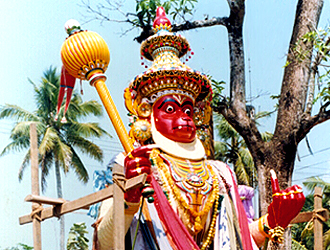 Kettukazhcha exhibits skilfully sculpted and decorated forms of six temple cars known as `Kuthira` (Horses). It comprises of five Theru (Chariots) and icons of Bhima and Hanuman. All the temple cars, chariots and the icons are gigantic in size and are larger than any other similar Kuthiras and Therus of other temples in the region. Chettikulangara Kettukazhcha is a sign of the architectural and artistic sharpness of the ancient people of Chettikulangara.
Kettukazhcha exhibits skilfully sculpted and decorated forms of six temple cars known as `Kuthira` (Horses). It comprises of five Theru (Chariots) and icons of Bhima and Hanuman. All the temple cars, chariots and the icons are gigantic in size and are larger than any other similar Kuthiras and Therus of other temples in the region. Chettikulangara Kettukazhcha is a sign of the architectural and artistic sharpness of the ancient people of Chettikulangara.
Historians believe that the concept of `Kettukazhchas` is similar to the architecture of the Buddha tradition in square, rectangular and pyramid shapes. Many historians consider that its present form is not more than 180 to 200 years old. According to them it began during the early part of the 19th century. According to a legend, a group of village chieftains and their workers went for civil works to construct the Kollam-Chavara Thodu according to the decision from the then ruler of the region. However they could not return to their native place due to delay in completion of the canal. They pleaded to the authorities but their request was not heeded to. During this they got an opportunity to visit the temple festivities at Kollam Mulankagakam temple and were attracted by the Kettukazhcha there. They vowed to Chettikulangara Bhagavathi deity that they would construct Kettukazhchas every year. They were allowed to return to Chettikulangara the very next day and they made huge Kettukazhchas and took them to the temple premises.
Kuthiras
Kuthiras are a union of four parts- Adikkoottu, Kathirakal, Edakkodaram, Prabhada and Melkkoodaram that have a height of about 70 to 75 feet. It is kept one above the other correspondingly.
Adikkottu is the basic structure which is also known as Vandikkoottu. It forms the basic foundation which consists of four big wooden wheels that are interconnected with four other beams above it. Kuthiras have Thandu, two long huge wooden poles that control the direction while moving. Thandu and the basic structure are interconnected. They have reinforced wooden bearings which are similar to the modern shock absorbers.
Kathirukal consists of four long poles that are interconnected with Arecanut poles known as `Alaku` and reinforced with coir and Panavalli knots. It is about 35 feet height. These are strengthened with `Kuthukathrika` which is a criss cross formation of Alakus.
Prabhada consists of wooden carved sculptors that depict stories from the Puranas and elephant caparisons called Nettipattoms, Thalekkettu and Aalavattom. They are displayed in the backdrop of colourful clothes and sculptors. Prabhadas have stories like Gajendramoksham, Vasthrapaharanam,Krishnavatharm.
Edakkoodaram is half the size of Kathirakal with four to five Charippu that comes above the Kathirakal. It had glittering different clothes and Vella that was interweaved with colourful Thookku embellishments.
Melkkoodaramthe is the top structure that is pyramidal. All separate units are pulled up and placed one above the other with the help of wooden pulleys and giant coir ropes.
Theru
Theru has no Prabhadas and Edakkoodarams. Their illithattu and charippu are larger than that of the Kuthiras. It diminishes as it goes upwards. Therus are smaller than the height of Kuthiras.
The wooden icons of Bhima are made by Mattom North and Lord Hanuman brought by Mattom south. Bhima`s icon is positioned as the Pandava who is on the way to kill Baka on Pothu Vandi with food for the Rakshasa King. Mattom south kara brings Patanjali`s icon along with Hanuman
Right from Shivaratri the preparations for constructing the Kettukazhchas start. On the evening of Kumbhabharani, the Kettukazhchas are dragged to the temple by people and are paraded at the paddy field in front of the temple. After Bhagavathi`s Ezhunnellippu the Kettukazhchas are taken back to the respective Karas by next morning.





















